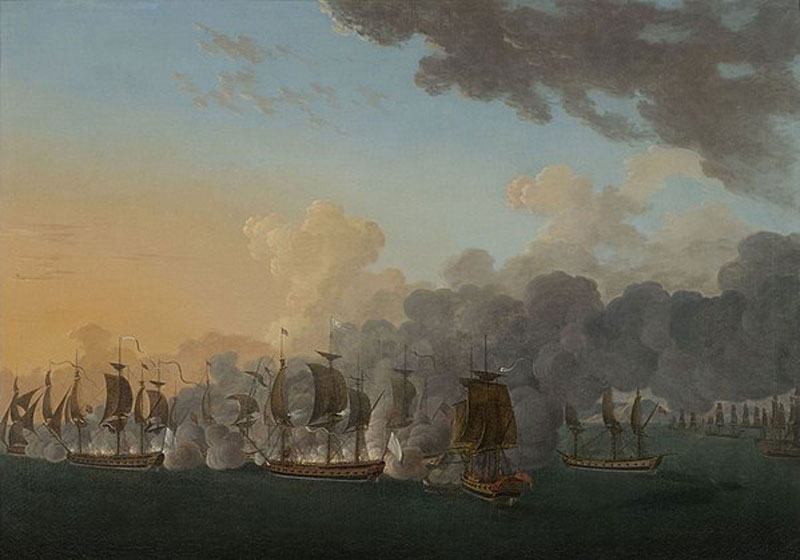
Three months before the last battle of the American Revolutionary War (or War of Independence, depending on the point of view) in July 1781, a British convoy off present-day Nova Scotia proved that point.
In escort were five British navy ships. Frigate Charlestown was the largest, but was undermanned and underarmed.
Most of the group’s merchant ships were supplying or picking up material from the mines on Cape Breton Island, one was carrying soldiers to work at the mine, and four were headed toward Quebec City laden with salt and flour.
In escort were five British navy ships. Frigate Charlestown was the largest, but was undermanned and underarmed. Accompanying were HM Sloop Vulture, HM Armed Ship Allegiance, a victualler, Thompson and Quebec Provincial Marine Ship Jack.
The convoy sailed north from Halifax, N.S., on July 18, and rounded Scatarie Island early July 21, then headed for Spanish River (now Sydney harbour).
Two unknown sails were spied in the distance at about 10 a.m. Signalling Vulture to follow, Captain Henry Francis Evans, commander of the Charlestown, set off to investigate. Jack followed.
Alarmed when the strangers were unable to answer Charlestown‘s coded signals, the three British ships left to rejoin the convoy at about 2 p.m.
The mysterious ships slowly sailed into view: the enemy. French frigates L’Astrée and L’Hermione were already cleared for action.
After losing its Canadian colonies in the Seven Years’ War, France had been looking to regain power in North America. It was quick to leap on the opportunity presented by the Revolutionary War, gaining an ally by supplying the Americans with arms, ammunition, troops and naval support.“I had desired so much the whole day to join the enemy,” wrote Jean-François de Galaup.
And that proved an advantage when the Anglo-French war broke out in 1778—the British had to stretch resources thin to fight in Europe and North America. French frigates frequently patrolled the Atlantic north coast looking for British prey.
“We chased and were forced to sail on the same tack, being three quarters of a mile [just over a kilometre] from the nearest ship,” reported Lieutenant de vaisseau Louis-René Levassor, Comte de Latouche-Tréville, captain of L’Hermoine. Unable to reach the convoy before it made shelter in the harbour, the French focused attention on the escorts, which had formed a battle line.
“I had desired so much the whole day to join the enemy,” wrote Jean-François de Galaup, Comte de La Pérouse, captain of L’Astrée. He first fired his gun at 7 p.m.
The French aimed to move up the British line from the rear, taking the smaller ships out of action so they could concentrate on Charlestown. The plan worked, according to a description of the battle on awiatsea.com.
“Captain Evans was wounded at the first broadside from L’Astrée’s guns,” and later died. “First Lieutenant David MacKay took charge of Charlestown. The Vulture moved up to support the Charlestown.
“The Charlestown was pouring a very ‘lively’ fire into L’Astrée.” L’Hermione was right astern. “Sailing faster than L’Astrée I doubled under the wind and found myself…forced to take the front, and then to sustain [the fire] of the Allegiance and the Vernon.”
George, in the Vulture, saw L’Hermione pull around L’Astrée, and “with much judgment and undaunted bravery” passed ahead of the Charlestown “to relieve her from so unequal a contest, by taking the fire of the Hermione… George brought her within pistol shot of L’Hermione, while the Charlestown and L’Astrée fought it out.”
The French were outraged that Charleston, which they thought had surrendered, began to sail away.
By this time, all the ships were damaged, sails were shredded and masts had been blown to bits, bringing down the rigging needed to operate. As cannonballs ripped through wooden masts and bulwarks, crews were sprayed with deadly slivers and shrapnel.
Twice L’Hermoine’s crew had to put out fires. Charlestown and Vulture were so damaged they could not continue to fight. Jack, fired upon from point-blank range, struck her colours and was captured.
By 8:15 p.m., the top mast of the Charlestown was shot away as well as the mast carrying the ship’s ensign. The French said the ship struck its colours indicating surrender, but the English maintained another flag was immediately hoisted to indicate Charlestown was still in action.
The Charlestown could not be seized so long as it was protected by the other British ships, so the French concentrated fire on them instead.
At 8: p.m., with darkness falling, the battle was over.
“Had we been favoured with two hours more of day-light, or a clear night, we should have taken six vessels,” said La Pérouse.
Accounts of what happened next also differ depending on point of view.
The French were outraged that Charleston, which they thought had surrendered, began to sail away. Since Jack was secure, its crew locked in the hold and guarded by sentries, the French gave chase in the dark.
“At 11 o’clock at night, not knowing what course the enemy had taken, I laid by,” reported La Pérouse, who hoped Charlestown was so damaged it would stop, too.
The British believed the French had received such a beating that they had sought safety in the darkness. The three British ships sailed away into the night, changing course to evade detection while they made repairs.
The next morning, a fog rolled in to conceal the British escort ships.
The frustrated French fled to Boston, arriving on July 23. The British limped into Halifax seven days later.
The French rued the nightfall. “Had we been favoured with two hours more of day-light, or a clear night, we should have taken six vessels,” said La Pérouse.
“Charlestown…was compelled to strike her flag but the darkness of night prevented us from taking possession of her,” said Latouche-Tréville.
The British praised the gallantry of Charlestown and Vulture, who not only escaped capture themselves, but prevented seizure of the convoy.
Advertisement













